In 1753, Carolus Linnaeus classified the plant kingdom for the Western World. In the process of doing so, Linnaeus classified and named the genus and species, Cannabis sativa. He concluded that the genus Cannabis has but one species, sativa. However, travel and communications were difficult in the 1750s, and Linnaeus was unaware of C. indica and C. ruderalis.
Kingdom: Plantae—all plants
Division: Magnoliopsida—magnolia class
Order: Rosales—nine families
Family: Cannabaceae—hemp family, flowering plants, about 170 species in about 11 genera
Genus: Cannabis—three species
Species: indica, sativa, and ruderalis
Varieties (misnomer of “strain”): infinite number of combinations
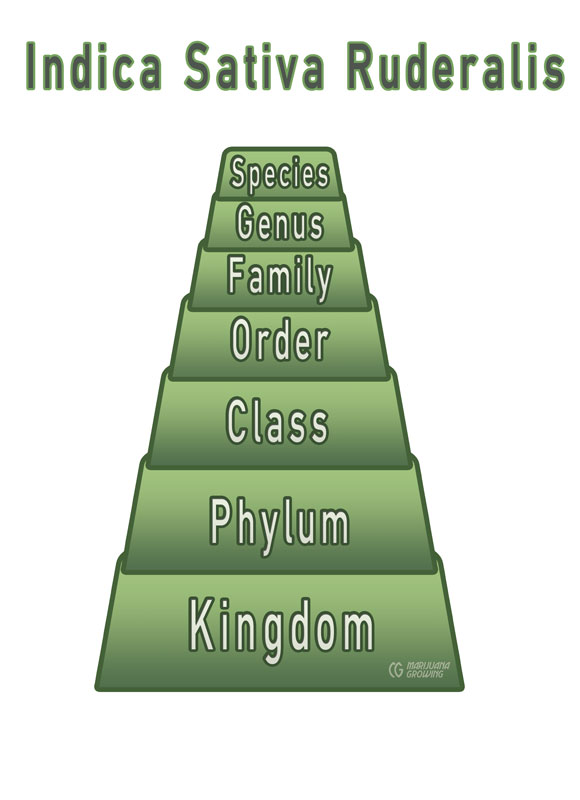
Here is a simple way to remember three important terms used often in this book:
genus = last name
species = first name
variety = nickname
Qualities of Cannabis
1. Annual dioecious flowering herb
2. Imperfect flowers (dioecious) = male and female + intersex plants (aka hermaphrodites)
3. Produces cannabinoids that are concentrated in glandular trichomes which appear on foliage, primarily on floral clusters
4. Wind pollinated
5. “Short-day” plants except C ruderalis—equatorial varieties are possibly autoflowering and may be “day neutral”
Cannabis Varieties
Legally, all cannabis, whether rope or dope, is classified as Cannabis sativa (C. sativa).* Regardless of origin, all cannabis is considered C. sativa under international law. However, according to Hemp Diseases and Pests authors Dr. J. M. McPartland, R. C. Clarke, and D. P. Watson, as well as CAB International, Cannabis sativa can be further classified as: Cannabis sativa (= C. sativa var. sativa), Cannabis indica (= C. sativa var. indica), Cannabis ruderalis (= C. sativa var. spontanea), Cannabis afghanica (= C. sativa var. afghanica). Each has a distinct growth pattern, look, smell, taste, etc. In this book, I have treated C. afghanica as a subspecies of C. indica. This is how it is classified by the majority of cannabis breeders and gardeners.
Cannabis sativa, C. indica, and C. ruderalis are most often bred together. Breeders cross the “varieties” together and select for desirable qualities in the offspring. See chapter 25, Breeding, for more information.
Medical cannabis gardeners grow varieties with different cannabinoid profiles. The cannabinoid profiles may change from plant to plant. Varieties with high levels of THC and CBD offer the most therapeutic value.
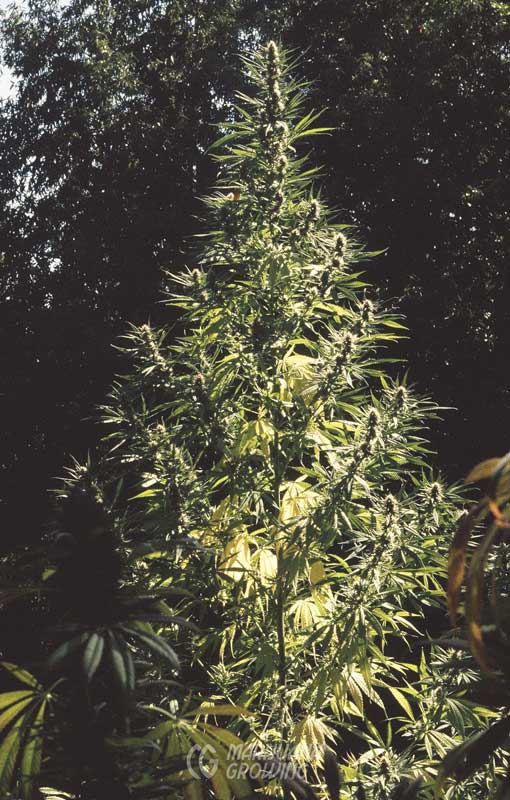
Cannabis sativa plants tend to grow tall, with much space between internodes and narrow-blade leaves. Image by Mel Frank (MF).

Cannabis indica is shorter, conical in shape, and has relatively wide leaflets.
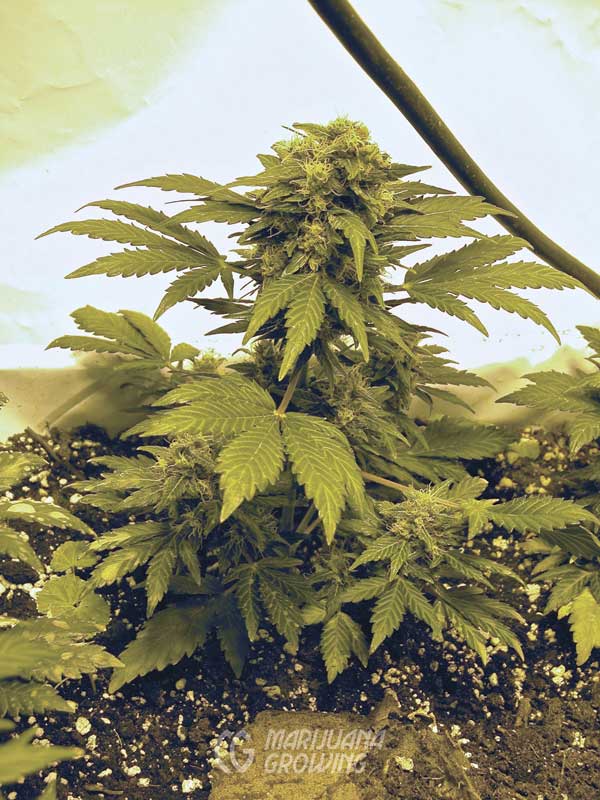
Cannabis ruderalis is generally short with few branches. It flowers after 3 to 5 weeks of growth, regardless of photoperiod.
Cannabis sativa
Cannabis sativa (= C. sativa var. sativa) originated predominately in warmer to tropical climates of Asia, the Americas, and Africa. Each area of origin lends specific characteristics, but all sativas have the following general traits: tall, sometimes leggy stature with more distance between internodes than C. indica; a large sprawling root system, large narrow-bladed leaves that tend toward lighter shades of green; and somewhat sparse flowers, especially when grown indoors under lights or in low light conditions. Female flowers start at branch nodes and typically develop along the length of the stem and branches rather than clustering around branch nodes. Flower formation is slower and less dense than with C. indica. C. sativa flower buds enjoy more air circulation and are less prone to fungus.
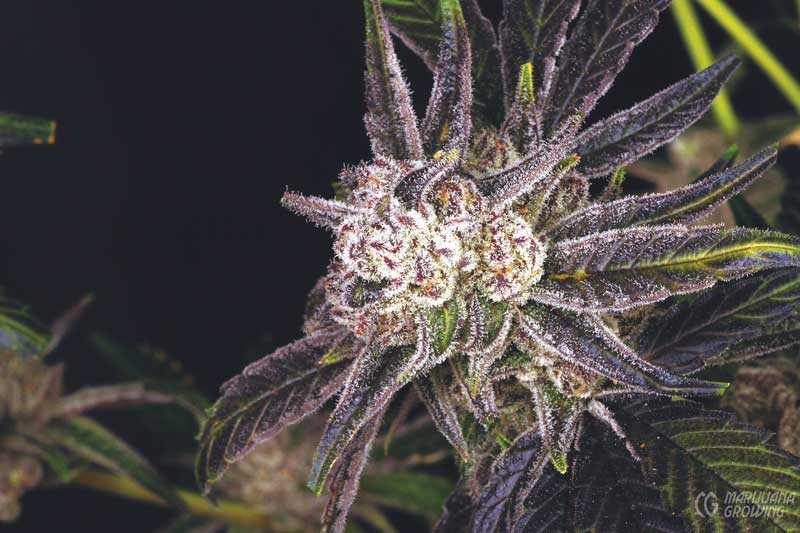
‘Peyote Purple’ from CannaBioGen is a good example of how C. indica leaves can also be narrow.
Overall, sativa varieties bloom later than indica varieties. While good producers outdoors, often growing to 15 feet (4.6 m) or taller, indoors pure sativa varieties often grow too tall too fast to be practical for grow-room cultivation. Some sativa varieties grow up to 10 feet in 3 months!
Central African sativas, including THC-potent ‘Congolese’, grow similarly to Colombian varieties with a tall leggy stature, often growing to more than 15 feet tall (4.6 m) with loosely packed buds.
South Africa has major seaports. Sailors brought C. sativa from many different places and planted it in South Africa. Consequently, the potency of South African cannabis can be very high or very low, and it can be short, tall, leggy, bushy, etc. The famous ‘Durban Poison’ yields pale-green, potent early buds and is the best-known South African variety.
Asian sativas, including Thai, Vietnamese, Laotian, Cambodian, and Nepalese, have diverse growth characteristics and vary significantly in potency. While Thai and other sativas from the area are often very potent, they are some of the most difficult to grow indoors and the slowest to mature. Thai varieties produce light, wispy buds after flowering for about four months on plants with large, sprawling branches. Thai, Vietnamese, Cambodian, and Laotian sativas are more prone to grow into hermaphroditic adults.
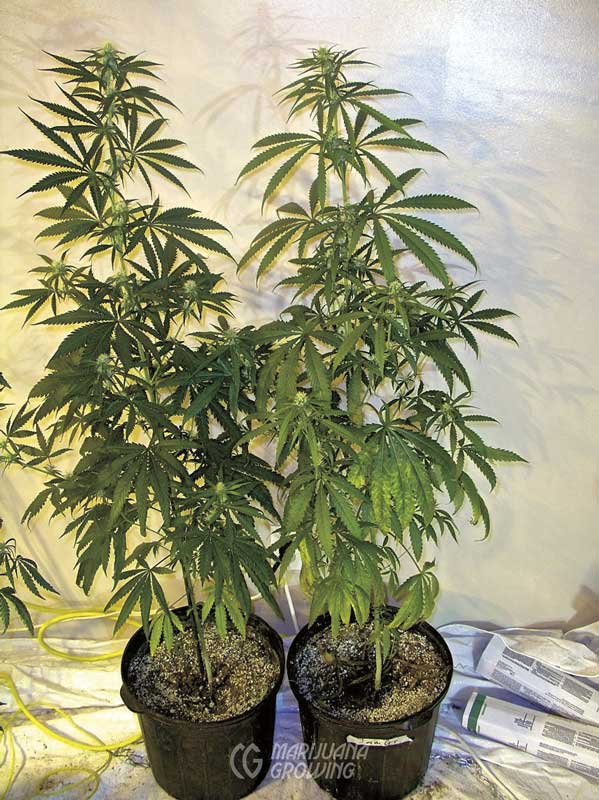
‘Jamaican Grape’ from Next Generation Seeds grows tall with more length between branch internodes.
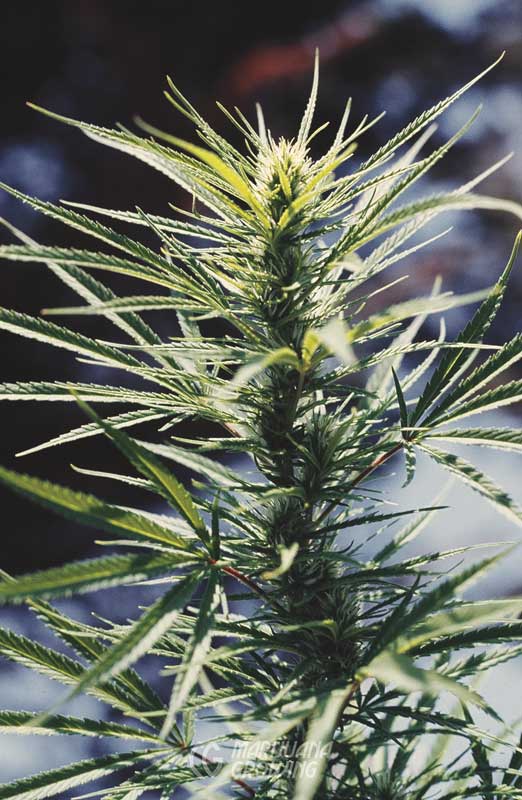
Seeds from this Thai plant grown in 1976 came from a “Thai stick,” a bud tied around a bamboo stick. (MF)
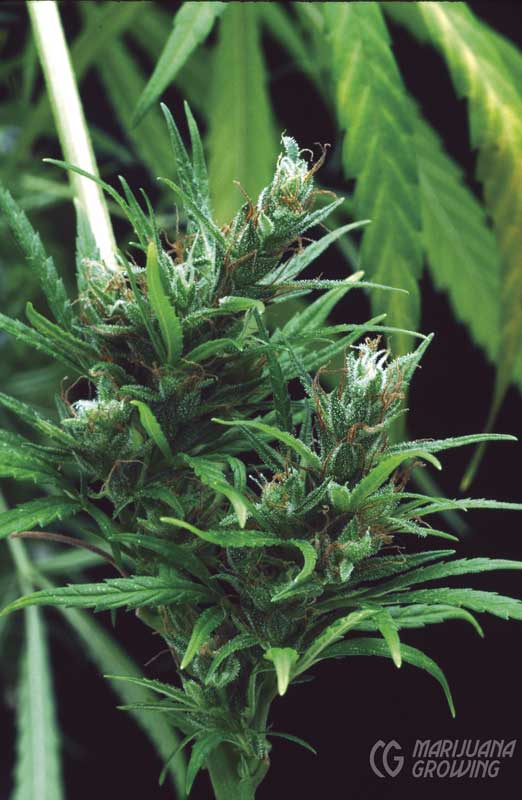
This South Indian landrace plant was part of a breeding program starting in 1977 by Mel Frank. (MF)
Nepalese sativas can grow oversized leaves on tall, leggy plants that produce sparse, late-blooming buds, but other varieties from this region develop into short, compact plants that bloom earlier. Tetrahydrocannabinol (THC) production and potency is often quite high, but can also be second-rate..
Industrial hemp is C. sativa. The tall varieties produce the longest fibers for a wide range of industrial uses. Hemp, affectionately referred to as “rope,” is often seeded and contains extremely low levels of THC and often very high levels of CBD.
Recreational C. sativa typically causes an energetic, cerebral, and inspiring effect, often followed by a desire to eat (especially sweet items)—aka “the munchies.” Craving food is especially important for patients who suffer from nausea or lack of appetite while undergoing chemotherapy, HIV/AIDS treatment, and other procedures.
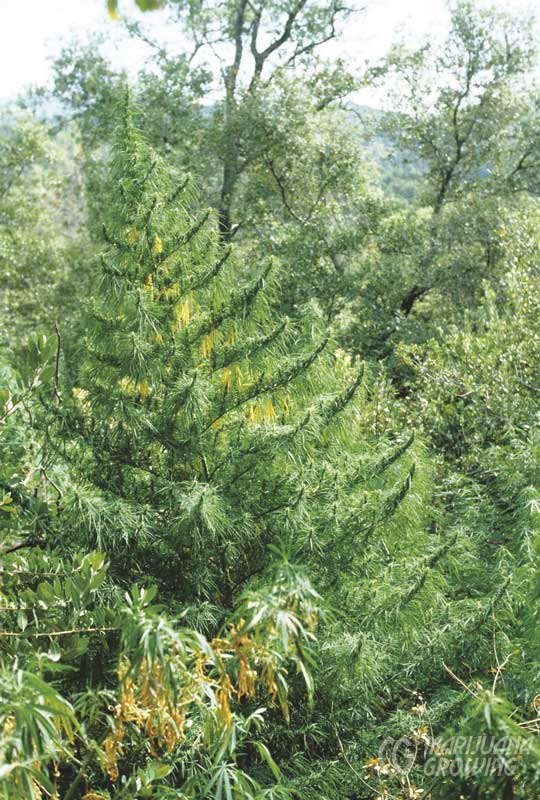
This large, robust Mexican sativa landrace was grown in 1978. (MF)
Mexican, Colombian, Thai, and Jamaican varieties can be very potent, with a high THC:CBD ratio that produces a soaring, energetic, “speedy” high. But potency can also be minimal, with low levels of THC. Most exported Colombian, Mexican, Thai, and Jamaican cannabis is poorly treated throughout life and abused when dried and packaged. This abuse causes more rapid degradation of THC. Consequently, seeds from fair smoke are often more potent than the parent.
C. sativa varieties grown indoors have been crossbred with C indica to reduce their height and flowering time. Sativa-indica hybrids generally take a little longer to flower than pure C. indica.
Cannabis indica
Cannabis indica (= C. sativa var. indica) was classified by European botanist Jean-Baptiste de Lamarck in 1785 from samples he believed to be from India. Today scholars largely agree that Cannabis indica L. originated on the Asian subcontinent or maybe in present-day Afghanistan.
C. indica is popular among indoor, outdoor, and greenhouse gardeners and breeders for its squat, bushy growth; condensed root system; thick stout stems; broad leaves with wide blades; and dense, THC-laden, fat, heavy flowers. Typically, indicas grow a maximum of 6.5 feet (1.9 m) tall and produce more side branches than sativas do. Typically foliage is very dark green, and in some varieties, leaves around buds turn reddish to purple. Short, whitish stigmas may turn reddish to purple under natural sunlight. Flower formation starts around branch nodes, and thick clusters of buds develop. Dry flower weight is typically much heavier for indicas than sativas.
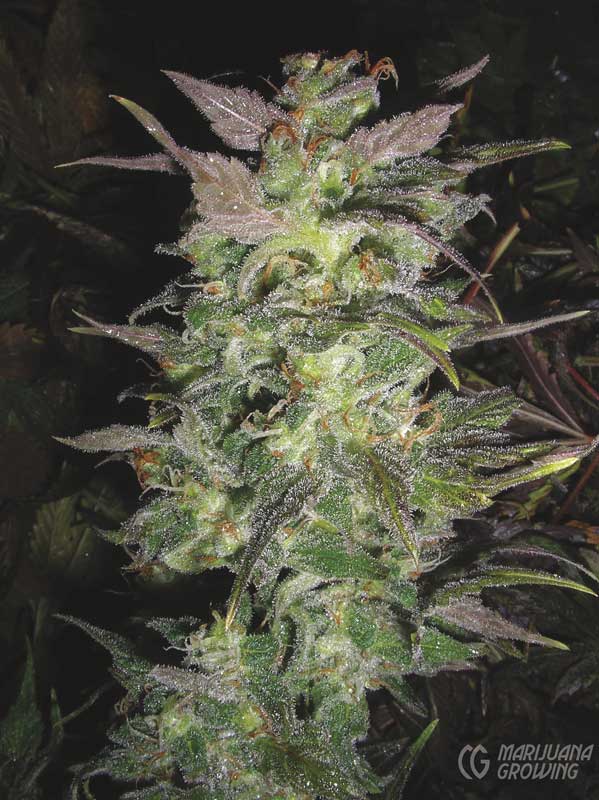
‘Strawberry Cough’ indica from Next Generation Seeds.
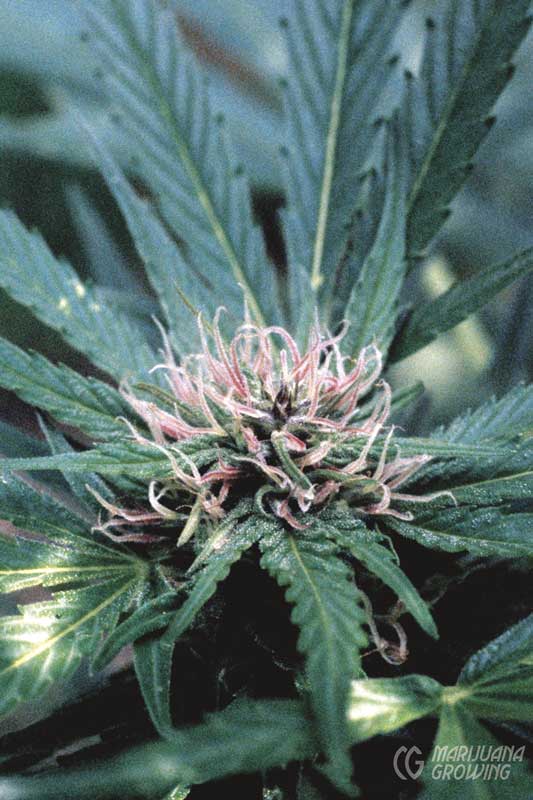
‘Pink Afghani’ × ‘African #3’ was an early Mel Frank hybrid, 1982. (MF)
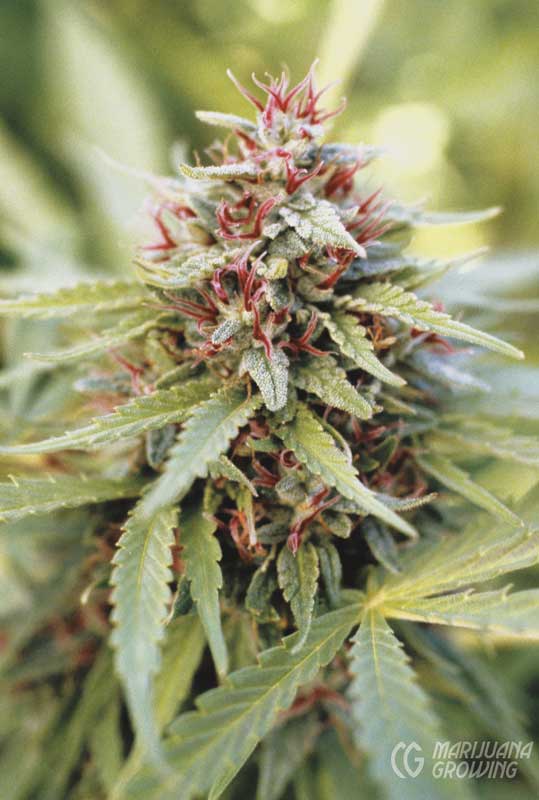
Original ‘Afghani #1’ from 1981 (MF)
C. indica varieties generally contain a higher ratio of CBD:THC and often contain more CBN than C. sativa does. Indicas tend to produce more corporeal effects, often described as a more physical, relaxing, and even incapacitating “couch-lock” effect. Side effects such as dry mouth may also occur.
Some indicas have a distinctive odor similar to that of a skunk or cat urine, while others smell sweet and exotic. Heavily resin-laden plants tend to be the most fungus- and pest-resistant. Few indicas with heavy, dense, compact buds are resistant to gray (bud) mold.
Cannabis afghanica (= C. sativa var. afghanica) could be classified as a subspecies of C. indica. It originated near present-day Afghanistan. It is quite short, seldom reaching 6 feet, with distinctive, broad, dark-green leaflets and leaves. Dense branching and short internodes, most often with long leaf stems (petioles), dominate the profile of C. afghanica. The most common examples of pure C. afghanica include the many different hash plants and Afghani varieties. C. afghanica is cultivated exclusively for drugs with much of the resin being made into hashish. It is known for its high cannabinoid content. Many growers and breeders do not distinguish C. afghanica from C. indica, lumping them both into the C. indica category. ‘Hash Plant’, of which there are many, is one of the classic C. afghanica varieties.
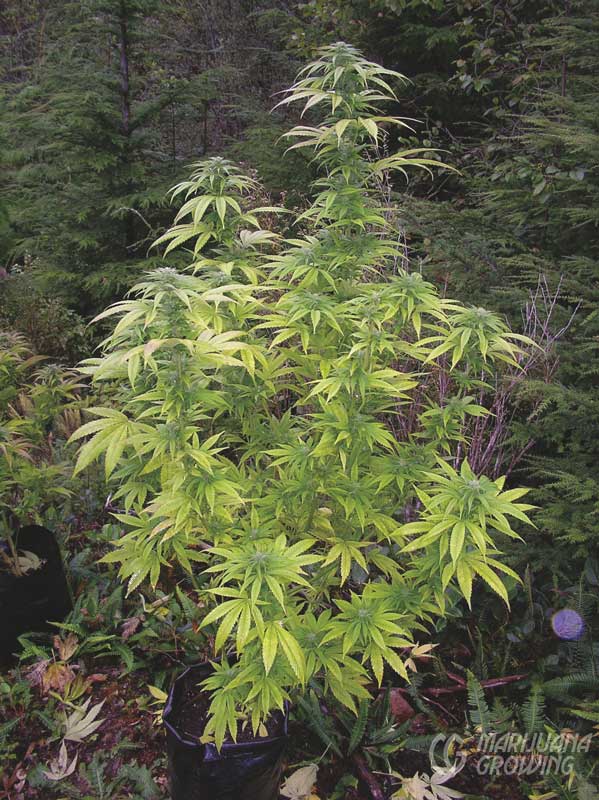
‘BC Kush’ from Next Generation Seeds shows classic short-and-squat growth.
Cannabis ruderalis
Cannabis ruderalis (= C. sativa var. ruderalis) (= C. sativa var. spontanea). Botanists disagree as to whether C. ruderalis qualifies as a separate species or subspecies. Russian botanist D. E. Janichevsky hypothesized in 1924 that ruderalis found in central Russia was C. sativa or a separate species, C. sativa L. var. ruderalis Janisch. In 1929 Nicolai Ivanovich Vavilov, a well-known plant explorer, named wild and feral populations of cannabis in Afghanistan C. indica Lam. var. kafiristanica Vav., and wild and feral populations found in Europe C. sativa L. var. spontanea Vav.
Ruderalis varieties are generally believed to have C. indica ancestors that acclimated to harsher climates. C. ruderalis is very short, from 1 to 2.5 feet (30.5–76.2 cm) tall at harvest and has a weedy, scrubby growth habit. Branching is sparse and leaves have wide blades similar to C. indica but are often a somewhat lighter shade of green. Stems are thick and sturdy. Flowers are small and moderately dense. Root systems are adequate to support small plants.
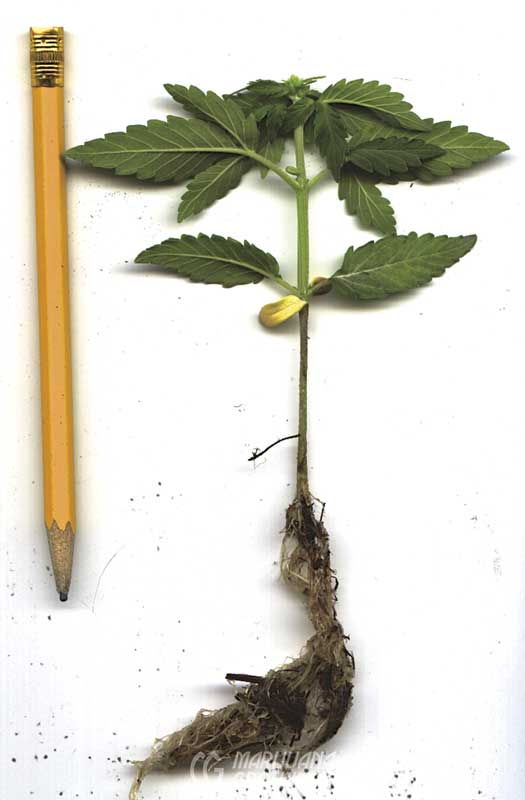
Seedling of the original ‘Lowryder’.
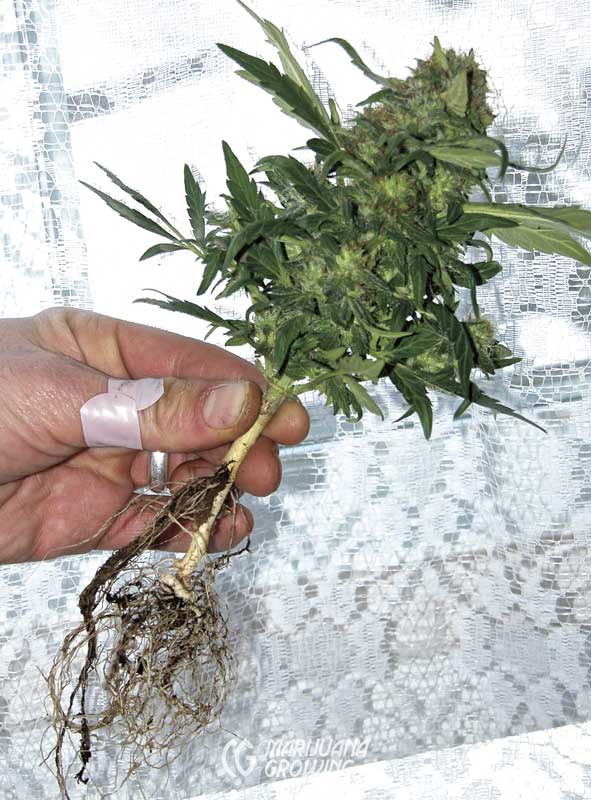
One of the first flower tops from ‘Lowryder’.
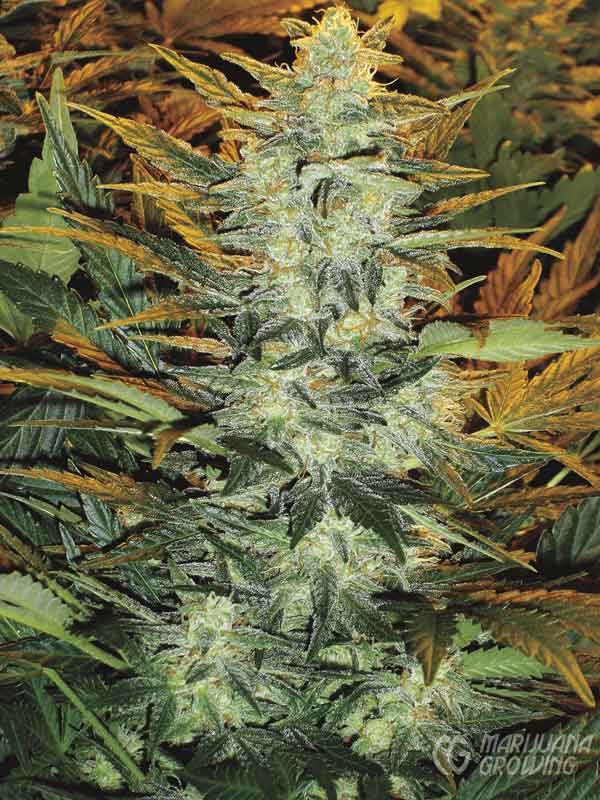
The next step in development was called ‘Lowryder #2’.
C. ruderalis is unique among cannabis, in that it flowers according to stage of maturity, typically after the fifth to seventh pair of internodes appear. C ruderalis crosses available today usually flower 21 to 30 days after planting seeds. Mature plants are ready for harvest in 70 to 110 days regardless of the photoperiod. C. ruderalis flowers and reproduces according to an individual plant’s age, regardless of the photoperiod.
The word ruderalis comes from ruderal. In the plant kingdom, ruderal means “the first species to colonize land disturbed by humans or natural occurrences.” C. ruderalis is native to Asia, Central Europe, and Russia, and adapted to the harsh environments found in these climates. It is adapted for life in extreme northern climates with short, 3-month growing seasons.
C. ruderalis varieties are crossed with C. sativa and C. indica varieties to incorporate the daylight neutral gene. Breeders are hybridizing plants with the autoflowering gene from C. ruderalis that incorporate qualities from C. sativa and C. indica: robust growth stature, large flowers, and cannabinoid profile. See “Autoflowering Feminized Cannabis”.
Feminized Cannabis
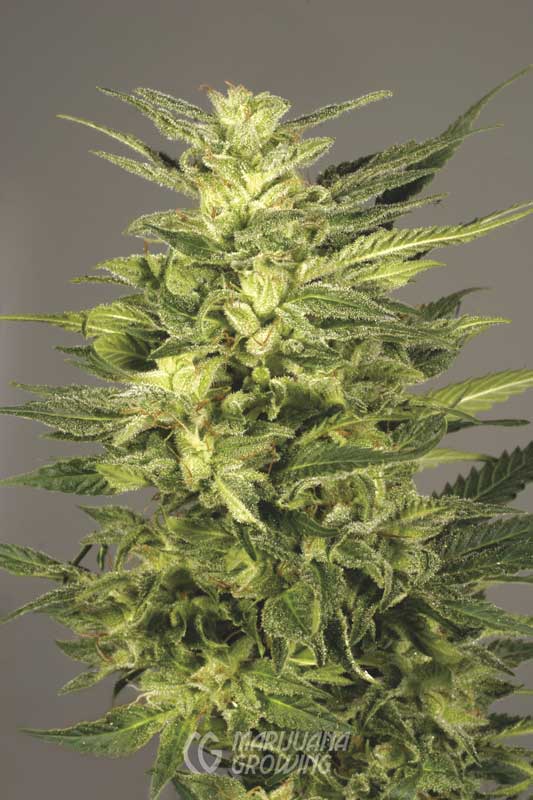
‘Jorge’s Diamonds’ from Dutch Passion is a popular feminized variety. Cannabis seeds are available feminized or in female version only. Virtually any cross or variety can be feminized. See chapter 25, Breeding, for information on feminizing plants.
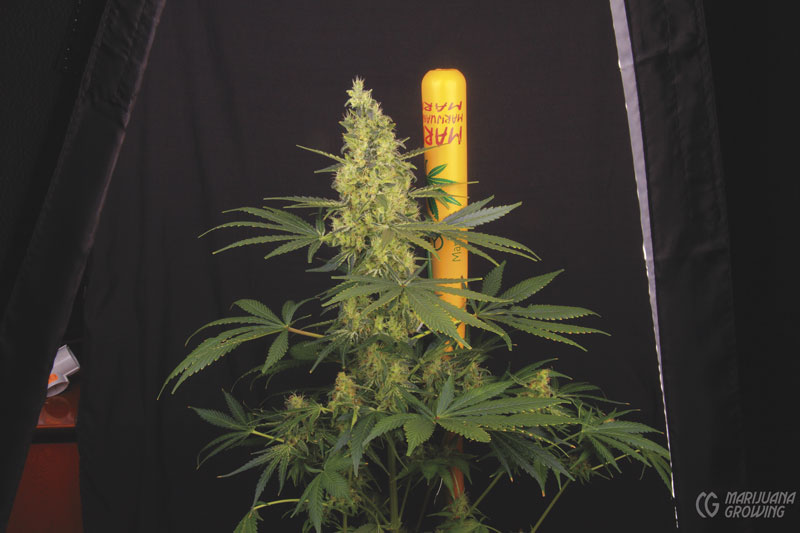
‘Black Jack’ from Sweet Seeds is a new variety, one of the many new feminized varieties released every year in Europe.
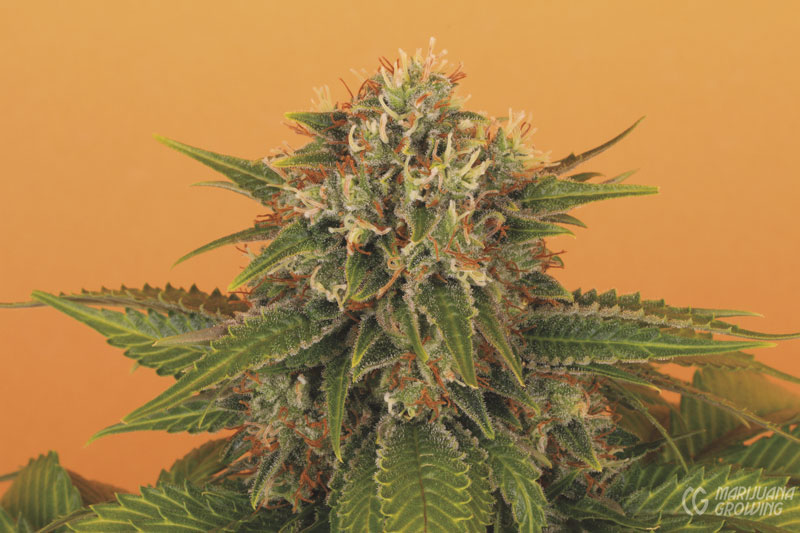
‘Kalashnikova’ from Royal Queen Seeds is another example of a new feminized variety from Europe.
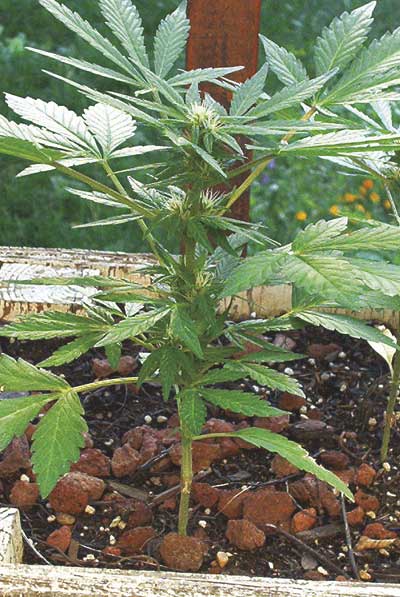
This ‘Lowryder’ female is just starting to flower.
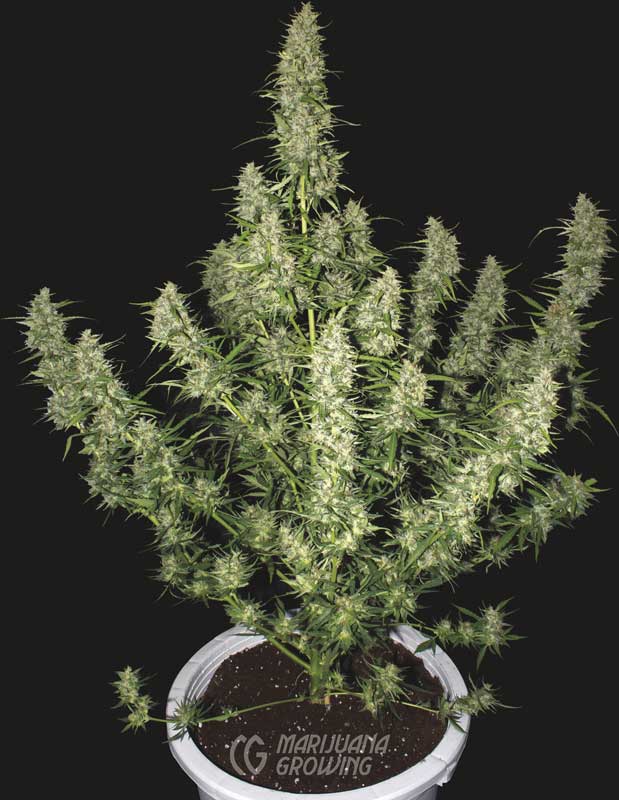
Autoflowering feminized ‘Magnum’ can be found at the Spanish company Hemp Trading (www.hemptrading.com).
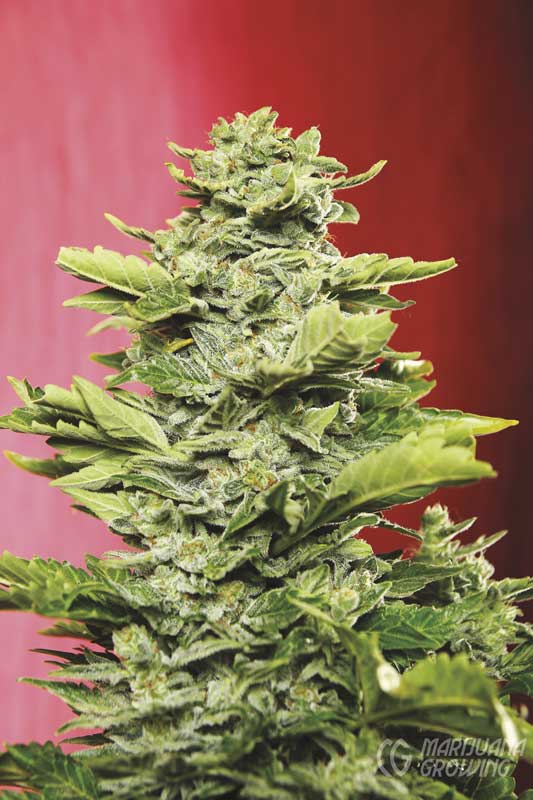
EZ Ryder is another auto-flowering variety developed by the Joint Doctor.
Autoflowering Feminized Cannabis
Autoflowering feminized cannabis plants were originally popularized by the Joint Doctor, a longtime cannabis gardener and breeder. These varieties have almost all the characteristics of regular cannabis varieties but they flower automatically. The autoflowering gene can be incorporated into daylight-sensitive cannabis plants that flower under a 12/12-hour day/night photo-period so that they flower after 3 to 4 weeks of growth.
Indica-dominant varieties are very popular because they naturally flower early and the trait is easy to select. Sativa-dominant autoflowering plants are often called semi-autoflowering or super-autos because they start flowering after about 28 to 32 days of growth. These plants can grow to more than 5 feet (1.5 m) tall. At harvest (90 to 110 days after planting), super-autos yield up to 4 ounces (113.4 gm) of dried flower buds. The extra days of growth translate into higher yields. Original and smaller autoflowering seed flowers in about 21 days, matures into ripe buds in 55 to 85 days, and yields up to 2 ounces (56.7 gm).
Autoflowering cannabis is perfect for cool and cold climates with short growing seasons. Autoflowering and super-auto seeds grow easily outdoors in alpine and northern climates having short summers with very long days and short nights. The plants can be started indoors and moved outdoors after 3 weeks of growth. Autoflowering plants are also quite resistant to cold, diseases, and pests.
Outdoors in warm climates, gardeners can harvest 3 or more crops of autoflowering cannabis!.
Super-autoflowering plants are mostly sativa, and grow bigger than original autoflowering plants, reaching 6.5 to 8 feet (2–2.4 m) under proper conditions. Super-autos share the other qualities of autoflowering plants flowering under any light regimen and can be feminized too. They differ in that Super-autos grow for up to 30 days before they initiate flowering. Plants grow bigger during a longer vegetative growth stage. Larger vegetative plants have more branches and foliage and produce more flower buds. Each super-auto plant can yield 3.5 to 9 ounces (99.2–255 gm) of dry flower buds when grown outdoors under the proper conditions. Plant super-autos in spring and summer. Harvest 90 to 100 days after seeds pop through the soil.
Stitch, a French breeder, started developing super-autos from Mexican and Guatemalan genetics in the late 1990s and continues to develop more varieties today. Look for ‘Chaze’ super-auto and other varieties.
Indica / Sativa Crosses
So many varieties are the result of just two original varieties—‘Skunk #1’ and ‘Haze’. ‘Skunk #1’ is a fabulous plant. It was the first stable cannabis variety. These two plants are the cornerstones of modern cannabis breeding.

‘Power Plant’ from Dutch Passion

‘Sensi Star’ from Paradise Seeds
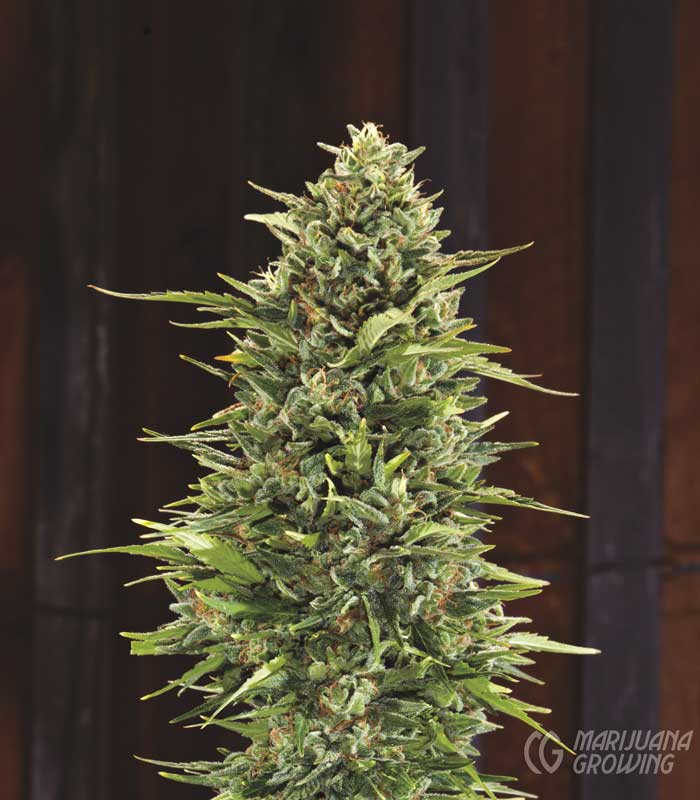
‘Skunk #1’ at peak resin production.
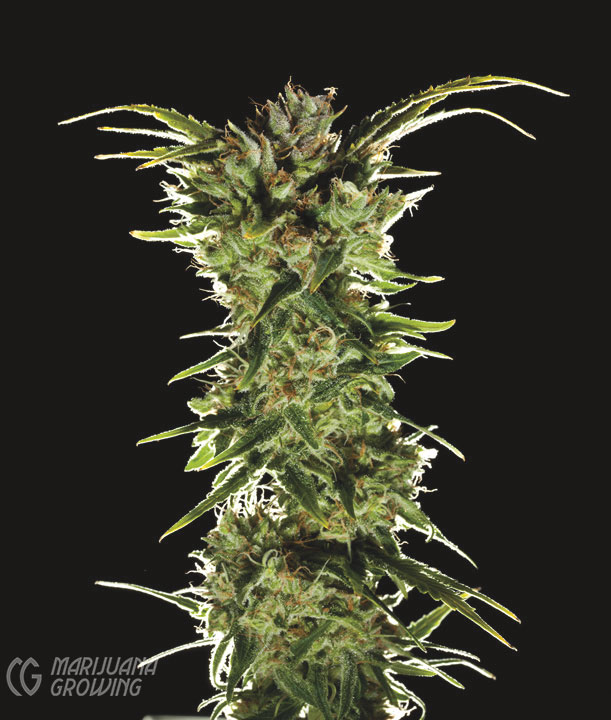
‘Catatonic’ from Resin Seeds is high in CBD.
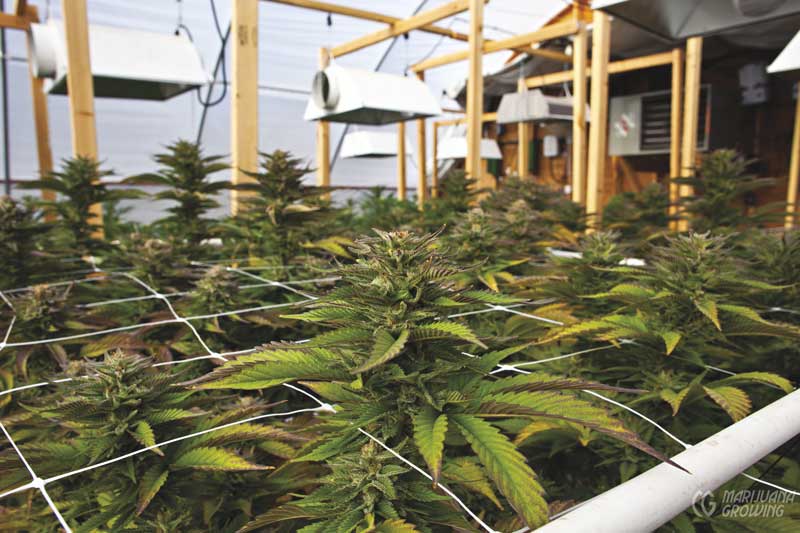
CBD-rich ‘Harlequin’ from SOHUM Seeds
High-CBD Varieties
About one out of 500 samples brought into California cannabis testing labs in 2012 had high levels of CBD. Cannabis can be selectively bred for high CBD levels. Several breeders have taken on the task, among them Jaime from Resin Seeds (Spain) and Lawrence Ringo from SOHUM Seeds (Southern Humboldt Seed Collective, California). Other breeders are hot on their trail, developing CBD-rich varieties as we speak.
High THC Varieties
There are many THC-rich varieties available to medical cannabis gardeners today. In fact, most of the varieties are loaded with THC-rich cannabinoids and can be grown well indoors, outdoors or in a greenhouse.
‘Haze’ has been my favorite variety since 1983 when Nevil, Founder of the Seed Bank in the Netherlands, gave me a big branch for my trip back to Amsterdam from the Cannabis Castle. This is my all-time favorite variety! This opinion is shared by countless cannabis aficionados. Developed in the early 1970s by the Haze Brothers in Central California, original ‘Haze’ was bred by crossing Colombian/Mexican hybrids during the first year. A South Indian male was crossed with the best Colombian/ Mexican female offspring during the second year. The third year, the best females were crossed with an imported Thai male. Now there are many versions of the “Original Haze.” Nevil’s ‘Haze’ is one of the strongest I have seen.
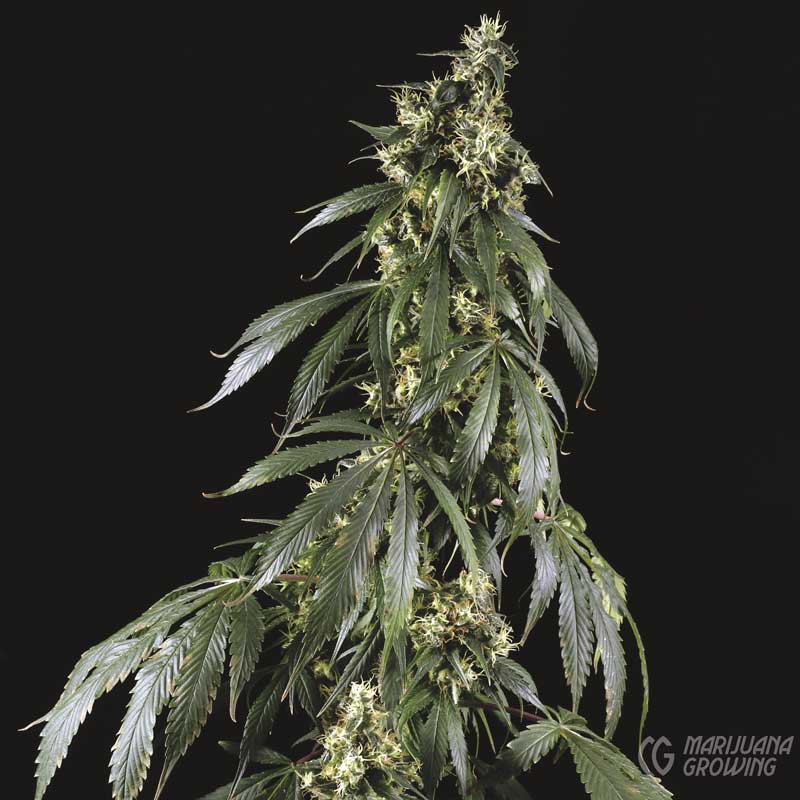
‘Arjan’s Haze’ (The Greenhouse) is one of the many ‘Haze’-based varieties available today.
A safe estimate is that ‘Haze’ is found in the genetics of 10 to 15 percent of cannabis varieties today.
‘Haze’ is often crossed with other varieties that ripen much quicker. Some of the favorite crosses include: ‘Buddha’ (Dutch Passion), ‘Fuma con Diablos’ (Flying Dutchmen), and ‘Northern Lights #5’ × ‘Haze’ (Sensi Seeds). Of course, there are many “Original Haze” varieties!.
Taste—distinctive sweet and spicy, pine-lemony
High—clear, up, soaring, vivacious, animated
Potency—some varieties more potent than others
Genotype—sativa, Colombian, Mexican, Thai, and South Indian
Culture—difficult, long maturing, hyper-prone to overfertilization
Odor—Smell it once and you remember its distinctive odor forever!
Habit—long and lanky with wispy buds
Yield—low
Disease/pest resistance—very resistant to diseases and pests
Indoors—three months or more
Outdoors—harvest late-December through February
Ease to manicure—slow
Water hash quality/quantity from trim—good
‘Skunk #1’ is the ultimate classic! Nearly half of Dutch-grown seeds and Canadian varieties today have a portion of ‘Skunk #1’ genes. ‘Skunk #1’ was developed in 1978 by California-based Sacred Seeds. This single variety transformed cannabis breeding in the Netherlands and the rest of the world. It has been the winner of numerous harvest festivals, including the Cannabis Cup in Amsterdam. You cannot go wrong with this variety. Sensi Seeds registered the name, but you can find this variety at numerous seed banks, and there is a little bit of skunk in countless other varieties. This long history has made ‘Skunk #1’ (and most of its direct derivatives) one of the least-expensive varieties available.
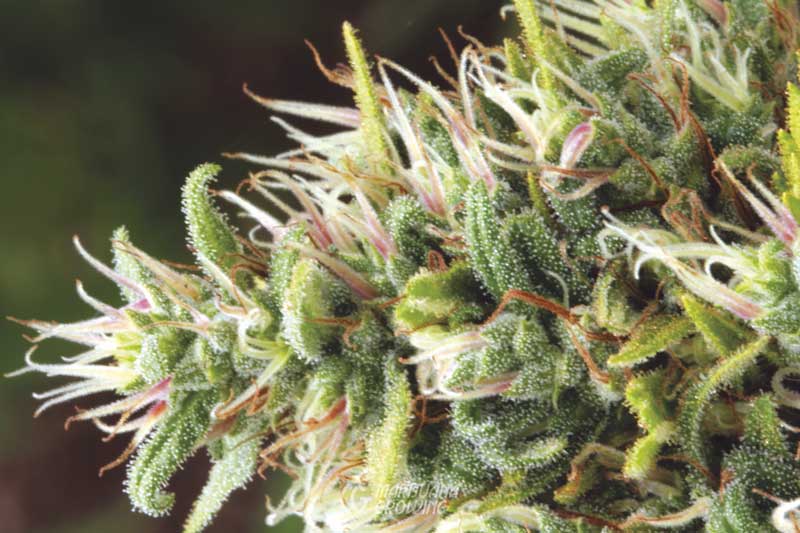
‘Original Skunk #1’ was developed by Sacred Seeds. (MF)
‘Skunk #1’ is probably part of the genetics of 30 percent of the varieties available today.
Taste—skunky, sweet
High—soaring, cerebral
Potency—strong but able to function on it, low CBD
Genotype—‘Colombian’ sativa/ ‘Afgani’ indica × ‘Acapulco Gold’ Mexican sativa
Culture—easy to grow but sensitive to overfertilization
Odor—distinctive, skunky and sweet, strong but not overpowering
Habit—high flower:leaf ratio; thick long colas; prone to long internode space
Yield—very high
Disease/pest resistance—susceptible to mold during flowering
Indoors—50 to 70 days, many early-flowering varieties are available
Outdoors—mid October, excellent greenhouse crop
Ease to manicure—very easy
Water hash quality/quantity from trim—good
‘Northern Lights’ (‘NL’) was developed by “The Indian” on an island in the Pacific Northwest. He started with 11 seeds and named them ‘NL #1’, ‘NL #2’, etc. Of the plants, ‘NL #5,’ ‘NL #8’ and ‘NL #1’ were the best, in that order. Nevil shuttled clones back to Amsterdam from Seattle, Washington, in the mid 1980s. Today, ‘NL #5’ is the main variety of ‘NL’ in use by breeders. ‘Northern Lights #5’ is often crossed with other varieties such as ‘Blueberry’, ‘Haze’, ‘Juicy Fruit’, and ‘Jack Herer’. Varieties are available from Sensi Seeds (who has registered the Northern Lights name), Canadian Professionals, and Nirvana.
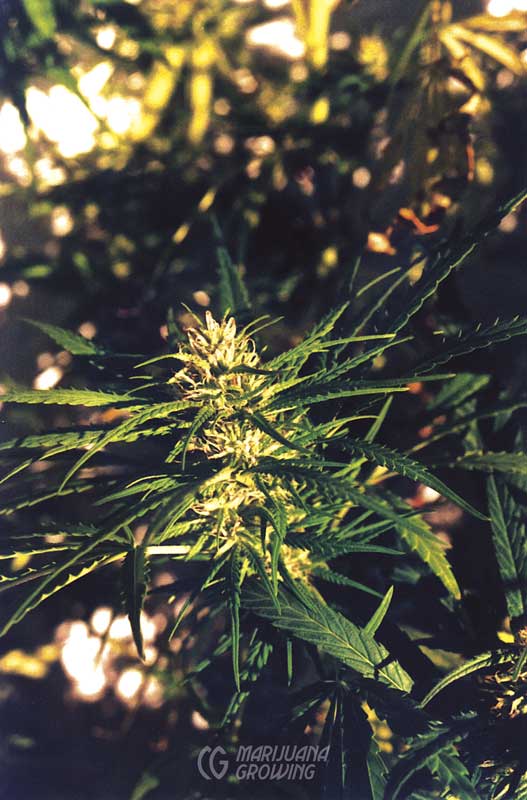
‘Northern Lights’ was one of the original, strong breeding plants.
‘Northern Lights #5’ is an absolute must if you grow indoors. This potent, user-friendly plant is also very popular among commercial growers.
Taste—strong, full-bodied, sweet, piney, hashy
High—body stone, couch-lock,
Potency—very strong, great resin production
Genotype—predominately Afghan indica/Thai sativa, very stable
Culture—easy to grow, can be pushed with fertilizer
Odor—sweet piney
Habit—high flower:leaf ratio, compact buds, purple tinge to leaves as plant matures
Yield—very good, a favorite among commercial growers
Disease/pest resistance—somewhat resistant to thrips and spider mites, best to cross with sativa
Indoors—60 to 65 days
Outdoors—early October
Ease to manicure—easy and fast
Water hash quality/quantity from trim—good but low volume

